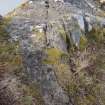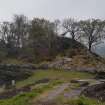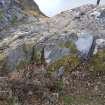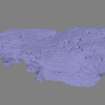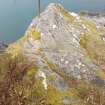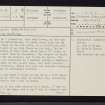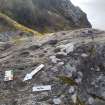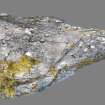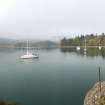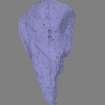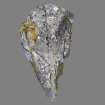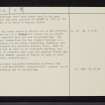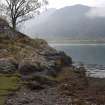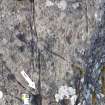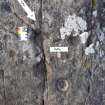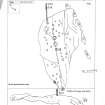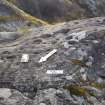North Ballachulish
Cup Marked Rock (Neolithic) - (Bronze Age), Whetstone
Site Name North Ballachulish
Classification Cup Marked Rock (Neolithic) - (Bronze Age), Whetstone
Canmore ID 23548
Site Number NN05NE 5
NGR NN 05778 59961
Datum OSGB36 - NGR
Permalink http://canmore.org.uk/site/23548
- Council Highland
- Parish Kilmallie
- Former Region Highland
- Former District Lochaber
- Former County Inverness-shire
NN05NE 5 0577 5995.
NN 057 599 On a promontory into Loch Leven, on the east side of North Ballachulish, 70 yards south from the NE mark (Iron ring) on the old jetty, is a cliff-like rock with an end post of an iron fence on its top. On the flat top surface of this rock, which has a 10 slope to the NE, are more than 60 cup-marks, the largest of which measures 14 cms in diameter and 10 cms in depth. The two largest are connected by a channel giving a dumb-bell effect and some of the lesser cups, too, have incised triangles The whole has no noticeable pattern.
Above these, and about 8 yards to the SE on a flat small ledge of rock at the sea edge is another cup, measuring 7 cms in diameter and 2 cms in depth.
On the summit of the rock outcrop is a basin, 17 cms in diameter and 7 cms deep, and a cup 7 cms in diameter and 2 cms deep.
These cup-markings have been known locally for more than 50 years and were reported to RCAHMS in 1972 by the Rev A Fergus of St Bride's Church, Onich.
Information in Ts by R W B Morris, undated; Information from Rev A Fergus, Onich (visited 27 July 1973) to RCAHMS 1972
The 60-odd cup marks noted by Morris are at NN 0577 5995. Some of them are well-formed but others are so slight that it is possible they are due to weathering. The short channel connecting the two largest hollows is a natural fissure, as are other connecting channels, and the two triangles are probably natural also. None of these marks can be said to be fish-bait mortars, and although it is probable that some are genuine Bronze Age cup-marks the number quoted by Morris is open to speculation. The other alleged cup-marks mentioned by Morris (at NN 0583 5992 and NN 0579 5995 respectively) appear to be natural, probably due to weathering.
Visited by OS (J M) 5 September 1974.
Note (20 April 2019)
Date Fieldwork Started: 20/04/2019
Compiled by: Callander
Location Notes: This panel is located above the shore of Loch Leven at North Ballachulish, about 750m eastwards from the old ferry jetty. It is on the W side of a small wooded promontory, almost an island but joined to the shore adjacent to a small concrete jetty by a small causeway which lies just above the high tide line. The panel is on top of an obvious small cliff, 5m directly above the sea at high tide. There is a large iron stake fixed into its top, making it easy to spot from the causeway from some 60m or so away. The location commands a beautiful view S and SW across Loch Leven over to one of the summits of Beinn a'Bheither to which the small jutting cliff, on which the panel sits, is directly aligned. Note that the water directly beneath the panel is very deep and the drop significant from its top so care needs to be taken.
A search was also made in the vicinity and over the promontory for the 7cm cup on a nearby 'rock shelf' and the 17cm basin and 7cm cup on the 'rock summit' which were reported in 1972. No evidence of these were found on the exposed rocks and these are now likely to be buried under heavy turf and heather scrub.
Panel Notes: 58 cup marks were counted, others have previously reported over 60 - some are very weathered and no doubt different counts would come up with slightly different numbers. Some of the cups are large, deep and well-defined: others much less obvious and perhaps not genuinely distinguishable from natural hollows. The 'triangular' lines that have been reported on the surface of the rock are natural cracks and fissures and some of the cups are intersected or bounded by these. Fine banding and colour gradations can clearly be seen within the deeper cups but as the rock is a metamorphic rock (orthogneiss) these are not bedding planes but a product of their metamorphism. There is an obvious longitudinal crack roughly down the centre of the top surface of the cliff. The crack connects the two largest cups down their centres and about 5 or 6 of the medium-sized and lesser cups. Beyond this alignment there are no other apparent patterns or groupings among the remaining cups and they appear to be scattered randomly of the panel's surface. The sizes of the cups range from the two largest at 14cm x 8cm; around 6 cups are 7-9cm in diameter x 2-4cm deep, other are a range of sizes smaller than these down to about 4cmx































